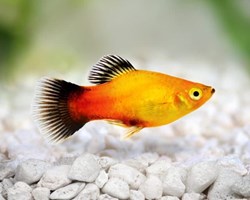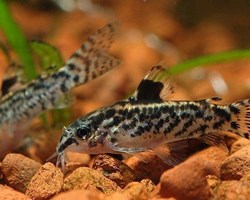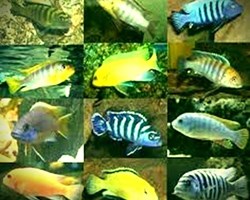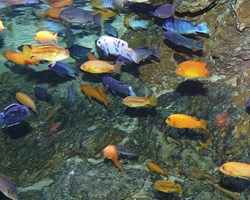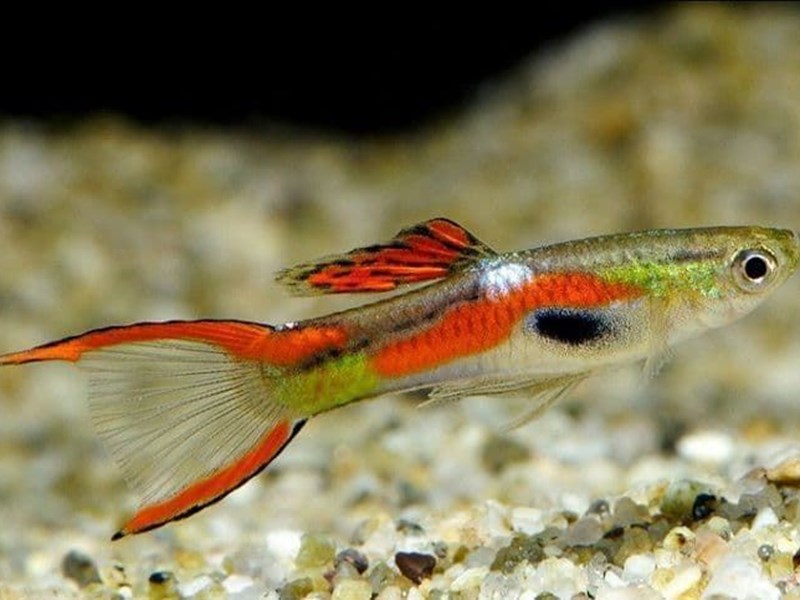
ENDLER'S GUPPY, POECILIA WINGEI;
It was discovered in 1859 by the German zoologist Peters, in Venezuela.
It belongs to the Poeciliidae family, which is home to a total of 351 different species of fish.
Guppies are from the same family as other very popular fish in the aquarium hobby, such as mollies or platies.
This family has some characteristics in common such as:
- modest size
- High resistance to variations in the parameters of temperature, pH, gH, etc.
- Ovoviviparous.
- The female gives birth to live fry, there is no external egg laying.
- Variegated colored liveries.
- Males are usually more colorful than females, with conspicuous streaks and spots.
- Mouth directed upwards, which gives us valuable information about their diet.
- School fish that like to aggregate and stay in groups.
This small Poecilian is the Poecilia wingei, Poeser, Kempkes and Isbrücker 2005 or Endler's guppy.
Guppies are probably the most widespread freshwater fish in the aquarium world.
Their small size, easy maintenance, and propensity to breed in virtually any environment have made them one of the most ubiquitous and valued freshwater fish.
The guppy is conspicuous by its colorful fan-shaped caudal fin (the tail), which it waves in quick, nervous movements throughout the aquarium.
It belongs to the Pecílidae family, which houses species of freshwater fish that are very varied in color and shape.
Interestingly, aquarium guppies bear little resemblance to their wild siblings, as their characteristic colors are the result of selective breeding.
The coloration of this small Poecilian is very variable, it can be determined as polychromatic.
What does not vary and is recognizable is its small size, not exceeding 2.5 cm for males and 3 cm for females.
They are also recognizable for not presenting a veiled tail and their caudal fin is transparent with a colored stripe above and below.
Males usually have a characteristic black band on the scales typical of wild Guppies.
The males are much more colorful than the females, and they fertilize them internally through a reproductive organ called the gonopodium.
In fact, sometimes it is even counterproductive how fast they reproduce.
If you mix males and females in the same aquarium, no matter how unpretty or comfortable it may be, the guppies will reproduce by filling the aquarium with offspring.
Females are silvery or brownish gray in color with a metallic sheen also resembling wild guppies.
It is native to the Laguna de los Patos (Cumaná), Laguna Campoma, Laguna de Buena Vista, Peninsula Paria and Carúpano, State of Sucre (Venezuela)
According to the German ichthyologist Dr. Wolfgang Staeck, Endler's Guppy, John Endler in 1975, would not be identical to the species described in 2005 in the Paria peninsular as Poecilia wingei.
In the different collection areas in Venezuela these small Guppies live in shallow estuary-type ponds.
In the rainy season these individual ponds communicate.
After the rainy season they are isolated again, leaving their water stagnant or with a very slight current.
This stagnation of the lagoons causes the gradual variation from fresh to brackish water due to the concentration of salts.
These lagoons present hard, turbid waters that are greenish in color due to the explosion of unicellular algae.
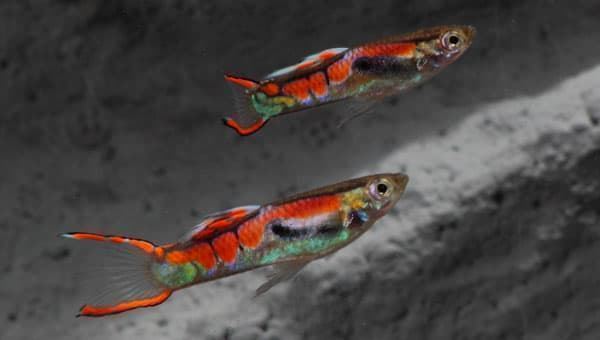
WHAT KIND OF AQUARIUM DOES A GUPPY FISH NEED AND ITS CARE:
The guppy fish is a fairly hardy species, and can withstand changes in aquarium conditions better than other fish.
It is very interesting to keep it in the aquarium whether you are a beginner or an expert.
General requirements that your aquarium should meet in order to have guppies:
- Do not keep more than one guppy for every 5 litres.
- If your aquarium is 60 liters, for example, you could keep up to 12 guppies.
- Dividing the liters of your aquarium by 5 you get the number of guppies that fit in your aquarium.
- Your aquarium should preferably have at least 20 or 30 liters so that the guppies have freedom to swim.
- That the aquarium does not have too strong currents.
- Guppies are active swimmers, but they will tire quickly if the water coming out of your filter generates rough currents, to the point of making it difficult for them to feed and causing great stress.
- If you have a filter with a high flow, consider reducing it, aiming the outlet jet towards the wall of the aquarium or placing the outlet near the bottom.
- Guppies usually swim between two waters and near the surface.
OPTIMAL AND STABLE TEMPERATURE:
The guppy fish adapts to temperatures between 18 and 28ºC, but the optimal temperature for them to be comfortable is between 20 and 25ºC.
The most important thing is that the temperature remains stable, sudden variations can cause diseases in guppies.
You should have with an aquarium heater.

HIGH HARDNESS AND NEUTRAL PH:
Your aquarium water should have a high hardness (gH) between 10 and 20, and preferably a neutral pH of 7 to 7.2 (although they can withstand pH 6.5 to 7.8.
They prefer planted aquariums, with abundant vegetation and hiding places.
Some plants that are very compatible with guppies due to their resistance are those of the genus Anubias sp, Java moss or Java fern.
The lighting should not be on for more than 8 - 10 hours.
Guppies also need day and night cycles.
The physical-chemical parameters of the lagoons can vary extraordinarily, temperature between 21 and 34ºC, pH between 6.9 and 9, hardness between 7 and 20ºdH, maximum salinity up to 1,020.
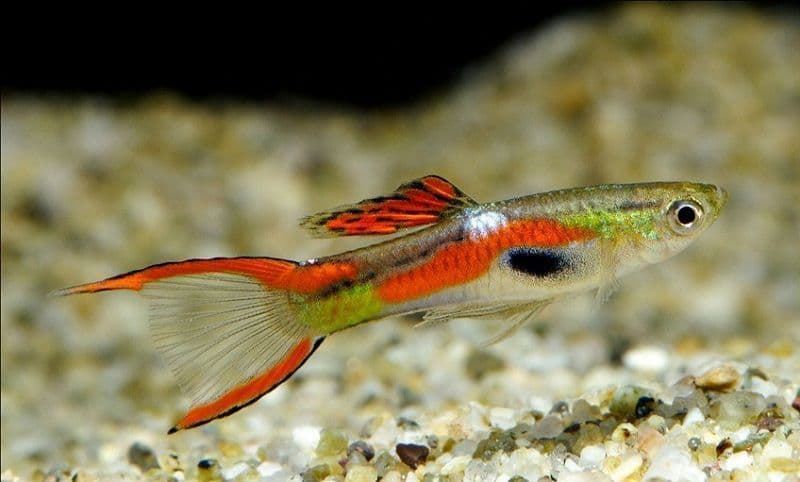
GUPPY FISH NUTRITION:
Guppies are omnivores and the more varied their diet, the more their colors will be enhanced and the easier it will be for them to grow healthy and reproduce.
- Dry food: Typical and easy to find in Glu Glu Pet, it can come in the form of flakes, powder, or tablets. The fry are fed dry, powdery, small-grained, easy-to-digest food. You can give adults flake food, in small amounts but several times a day (4-5 times). In this way we perfectly control the amount of food that we add to the aquarium, and we avoid excess food in the water (which can decompose and increase ammonium levels in the aquarium, the main cause of death of guppies).
You must put the right amount of food so that the guppies do not let anything sink to the bottom of the tank.
There are also flakes or powders of dried algae (Spirulina) that are very beneficial for them.
Dry food must be of good quality to avoid poor feeding.
At Glu Glu Pet we advise you that the guppy fish's diet should not be based exclusively on this type of food, but rather it should preferably be supplemented with other fresh and live ones.
- Fresh food: As guppies are omnivores, they can perfectly feed on vegetables, such as peas (peeled and very well cooked until they are soft, because if they are hard they will not be able to eat them). Peas are a good ally in the diet of guppies, who tend to suffer from intestinal problems when they are overfed. As peas are a great source of vegetable protein and fiber, they help prevent intestinal blockages. You can feed your guppies cooked peas 2-3 times a week if their entire diet is based on dry flake food, or once a week if you are also feeding them live food.
You can also make homemade porridge or purée containing carrot, spinach, beet (vegetable contribution) mixed with veal heart, chicken liver or some white fish (animal protein, very important in your diet).
Special care must be taken with these foods: if we overdo it and there are surpluses in the aquarium, it will be very polluting and could have fatal consequences.
- Live food: In the wild, the guppy feeds mainly on mosquito larvae. We can offer them this or other alternatives of live food, which will closely resemble their natural diet and will stimulate their colors, their vitality, their senses... some good examples of live food for guppy fish:
- Grindal Worms: Grindal worms are incredibly popular in the aquarium hobby, because they are so easy to keep, they reproduce terribly fast, and they are so nutritious for fish. Perfect for our guppies. They are white worms of about 8 mm that can be grown in tupperware with peat.
- Artemia salina: The guppy fry, which are tremendously small, find in artemia larvae a perfect food rich in protein. Eggs are usually sold and need to be hatched in the aquarium for the guppy fry to begin the hunt. It is quite a spectacle to see them eat brine shrimp. If you have a hypersaline environment nearby, such as a salt flat, you may find natural (and free) live brine shrimp.
- Red mosquito larvae: Don't worry, adults don't bite. There are brands that already sell freeze-dried (dried) red mosquito larvae. It is also common for other aquarists to sell them frozen. In fact, in the same milanuncios you can find many offers. You can also find them in rivers or ponds, in case you feel like going on an excursion.
- Tubifex sp: These worms can be found alive in ponds or rivers with a high content of decomposing organic matter. Before putting them in the aquarium you should keep them in a container with clean water for at least one day, with water changes every 8 hours, to "clean" them of contaminants. There are also aquarists who sell them frozen.
Food for guppy fry:
- 0 to 6 weeks: Newly hatched fry are given brine shrimp, which is what their little mouths and digestive tracts can encompass. Two days after birth you can start adding dry food powder. Feed small but many times a day (4 to 5 times).
- From 6 weeks: they are already adults. It is important to give them a balanced diet based on the foods that we explained before: vegetables, cereals, meat, fish, brine shrimp, worms, etc. A feeding routine recommended by guppy breeding experts is: brine shrimp as a first meal, a variety of dry foods during the day, and Grindal worms at night before lights out.
It accepts all kinds of food, including dried food, as long as it fits the size of its small mouth.
It is important to offer frozen foods and always complemented with spirulina algae.
Like the rest of the poeciliids, they are very fertile fish.
In this case, if they are well fed and the aquarium is well planted, they do not usually prey on the young.
In hard water they are quite prolific.
Gestation lasts between 23 and 27 days, always influenced by temperature, water quality and diet.
In each birth they can generate between 4 and 6 fry.
In the case of larger mature females, it can go up to 20.
Its hybridization with Pocelia reticulata generates fertile offspring, although it would be convenient not to mix them.
They have a relatively short longevity, not exceeding a year and a half.
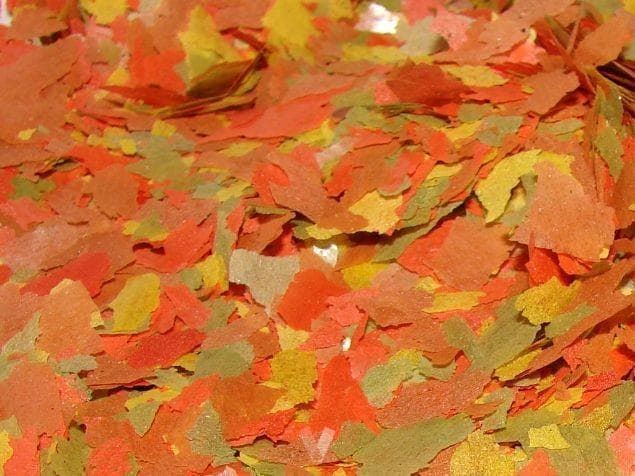
HOW IS THE REPRODUCTION OF GUPPY FISH:
The reproduction of guppy fish is very curious.
They are ovoviviparous fish, which means that the larvae develop inside eggs inside the female, and hatch there.
When the female guppy gives birth, the fry come out alive and ready to take their first meal.
There is no external egg laying, as there is with other species of aquarium fish.
The guppy fish is also known as the million fish, due to its ability to reproduce "in bulk".
As they are fish with a short life expectancy (up to 3 years if conditions are perfect), their strategy is to reproduce a lot and quickly.
Facts to keep in mind about the reproduction of guppy fish:
Fertilization is internal (another interesting feature and different from other fish).
The male introduces his reproductive organ (gonopodium) inside the female, fertilizing her.
The male can become very insistent, stressing the female to the point of making her sick or "abort" due to reabsorption of the eggs.
To free the females from the attention of the male guppy, it is recommended to maintain a ratio of 3 females to males.
A polygamous structure will be more beneficial for them.
In courtship, the males open their tail fin as wide as they can, in a colorful display and sinuous dances.
They also secrete chemicals that stimulate the female.
There does not seem to be a clear pattern of dance or color that most attracts females.
They have a predilection for orange tails.
Females can store sperm to become pregnant when there are few males.
HOW MANY PUPPIES CAN A GUPPY HAVE:
Depending on the age of the female, it will have more or less fry.
A first-time female in her first calving can have around 8 pups, and a mature female can reach more than 100 fry per calving.
Approximately two weeks after fertilization, a dark spot can be seen near the anal fin, which can be orange or darker.
Color may vary during gestation. In addition, the female is noticeably swollen compared to her companions.
Symptoms of a pregnant guppy fish:
- Reduce your activity.
- They tend to hide in the vegetation.
- His breathing becomes faster.
- His belly swells exaggeratedly.
- It goes from being round to square about two days before delivery.
- The spot of the fry is very close to the anal area.
- They don't feel like eating that much.
- Sometimes they go to the bottom of the aquarium.
The female will be pregnant for 4 to 6 weeks before giving birth.
It depends a lot on the quality of the water, the stress to which the pregnant guppy is subjected, age, etc.
TYPES OF GUPPY FISH BY COLOR AND SHAPE OF THE FINS:
Guppy fish are grouped into different types depending on their color and the shape of their caudal fin (the tail). In the following sections, all types of guppy fish are listed in a table.
Types of guppies fish by color:
- ALBINO GUPPY: The albino guppy has a recessive phenotype, characterized by the lack of melanin and the total absence of black, in addition to red eyes. Actually, an albino guppy can have many colors, except black.
- BLACK GUPPY: Black guppies must not have any other color. They are of medium size, if we try to obtain larger black guppies by selective breeding, what we will achieve is a decrease in color.
- BLUE GUPPY: Blue guppies display a wide range of color, which can range from turquoise blue to dark blue. The females, although less colorful, will have blue markings on their fins.
- HALF BLACK BLUE GUPPY (HB blue guppy): The blue and black guppy shows half a black body and blue fins.
- RED GUPPY: The pure red guppy, with a clean and bright color, has been achieved through selective breeding, mainly from albino and golden guppies, which minimize the amount of black melanin and achieve a red without degrading. Red guppies are usually somewhat larger in size.
- HALF BLACK RED GUPPY (HB red guppy): The red and black guppy is difficult to obtain, because the pure red tail is tried to be obtained from golden guppies, in which the black color is minimized, and the proportion is not usually maintained. perfect half red half black you are looking for.
- GREEN GUPPY: A green guppy is also quite hard to come by. It can range from light to very dark green. Many guppies are green mixed with blue highlights, and depending a lot on the type of light we have in the aquarium, it may not look green at all.
- HALF-BLACK GREEN GUPPY (HB green guppy): The green and black guppy variety has been "invented" by humans through selective breeding. It is difficult to keep the color black and the tail a pure green.
- YELLOW GUPPY: The yellow guppy can present shades from practically transparent to bright yellow. It is difficult to obtain, and they come from genetically golden specimens.
- HALF-BLACK YELLOW GUPPY (HB yellow guppy): The half-black yellow guppy variety is highly valued among guppy fish lovers. It is a difficult line to maintain.
- BRONZE GUPPY: For a guppy to be considered of this variety, it must have at least 25% of the body golden in color with scales with dark edges. Generally, bronze guppies have bicolor tails (green or red).
- GUPPY AOC (COLOR NOT CLASSIFIED): AOC guppies are all those whose colors do not fall into any IFGA category.
- AOC HALF-BLACK GUPPY (AOC HB guppy): Any guppy that does not fall into the category of black guppy or any other category of HB (half-black) guppy.
- BICOLOR AOC GUPPY: A bicolor AOC guppy is any guppy that does not fit into any other bicolor class (red, green or blue). For a guppy to be bicolor, it must have a base color (majority) and a second color that accounts for at least 25% of the color of the tail. If there was also a third color that made up 15% of the tail, it would be considered a multicolored guppy.
- BICOLOR RED GUPPY: A bicolor red guppy falls into this category if it has a red base color, and a second color (in this case black) that covers at least 25% of the tail.
- PURPLE GUPPY: Purple guppies have a uniform purple color (light or dark) on the tail and dorsal fin.
- HALF BLACK PURPLE GUPPY (HB purple guppy): HB purple guppies have half a black body and half (usually the tail and dorsal fin) purple.
- MULTICOLORED GUPPY: A multicolored guppy must have at least 3 different colors in the tail. Each color should cover at least 15% of the tail, and that pattern should be reproduced on the dorsal fin.
- GREEN-BLUE BICOLOR GUPPY: A green-blue bicolor guppy has a predominant color of blue, green or blue-green in the tail, and a secondary color that accounts for at least 25% of the tail. If there was a third color covering 15% of the tail, it would no longer be considered bicolor but multicolor.
- HALF BLACK OR HB PASTEL GUPPY: An HB pastel guppy has a half black body and pastel fins (any color except yellow). The most common are pastel white colors, and their purity depends a lot on the food they are given.
- FEMALE GUPPY: A female guppy has less display of color than the males, but females with bright patterns and the largest possible fins are rated best by veterans of guppy farming.
- SNAKESKIN GUPPY: The spots of the snakeskin guppy fish are in the form of small rings or rosettes. This pattern is generally associated with male guppies.
- GUPPY COBRA: A cobra guppy mixes a vertical spot pattern with a rosette pattern.
- GUPPY TUXEDO: The guppy tuxedo has a two-color pattern. It is also known as HB, Half-Black or half black.
- LEOPARD-TAILED GUPPY: The leopard-tailed guppy has large black spots, and the body can be snake-patterned or smooth.
- GRASS-TAILED GUPPY: The grass-tailed guppy has a dotted tail with small spots.
- MOSAIC TAIL GUPPY: The mosaic tail guppy has an unbalanced connection between the different spots.
- LACE-TAILED GUPPY: The lace-tailed guppy has a heavily criss-crossed, maze-like pattern.
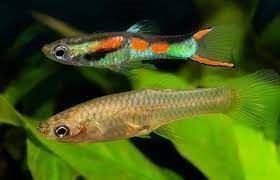
Other articles that may interest you:
- Molly.
- Platy fish or sunfish is one of the easiest fish to care for.
- Mollys, perfect fish for the community and beginner aquarium.

